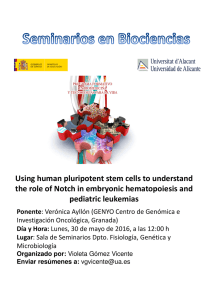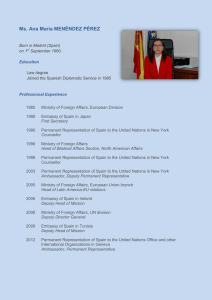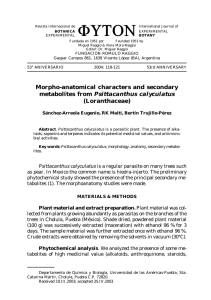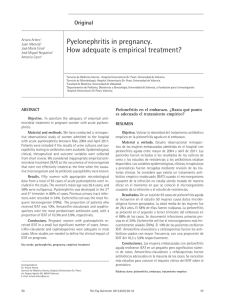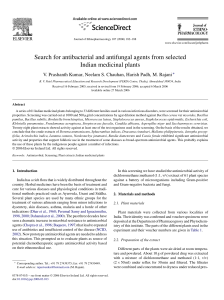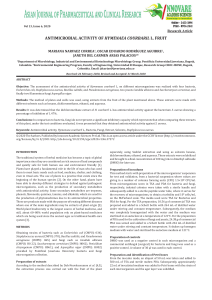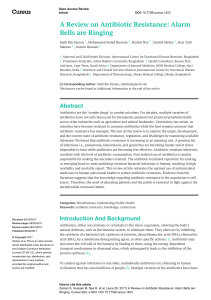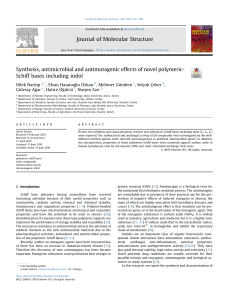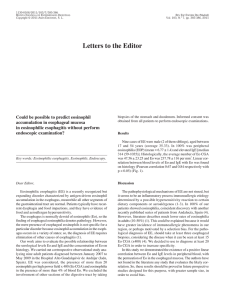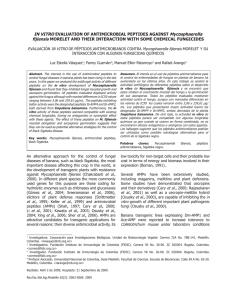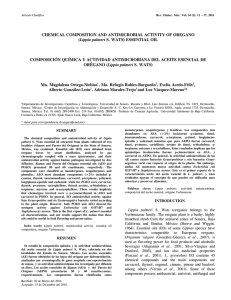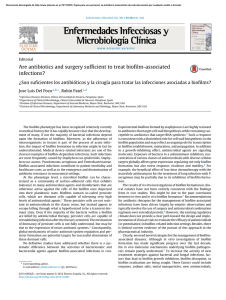Anuncio
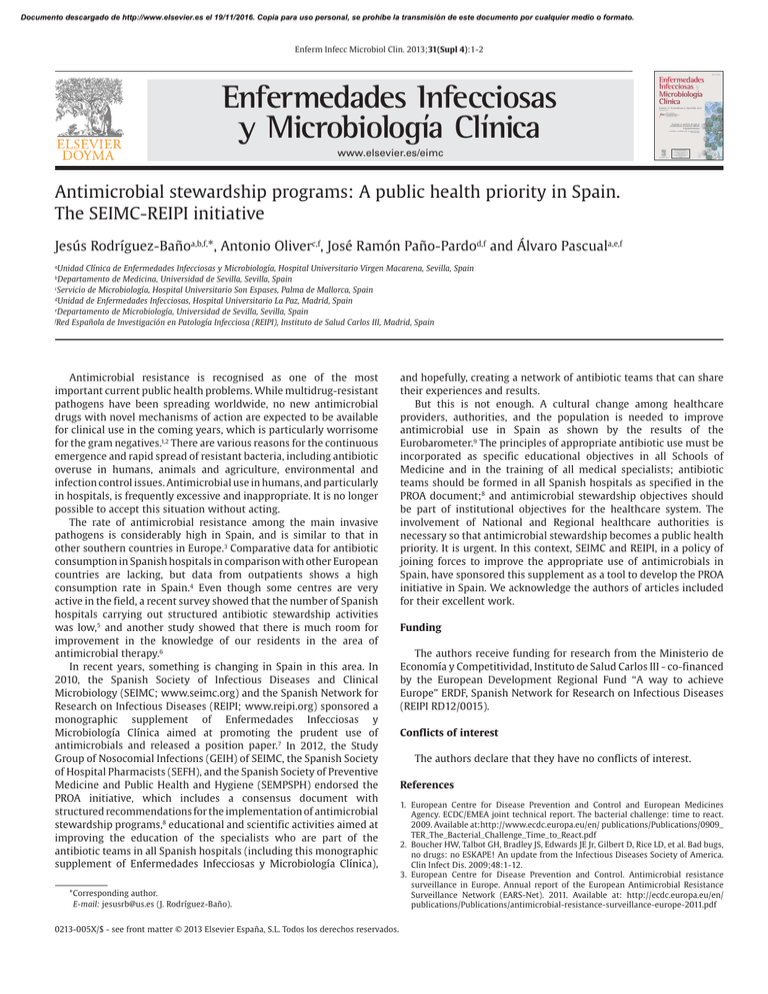
Documento descargado de http://www.elsevier.es el 19/11/2016. Copia para uso personal, se prohíbe la transmisión de este documento por cualquier medio o formato. Enferm Infecc Microbiol Clin. 2013;31(Supl 4):1-2 Enfermedades Infecciosas y Microbiología Clínica Enfermedades Infecciosas y Microbiología Clínica ISSN: 0213-005X Volumen 31, Extraordinario 4, Septiembre 2013 Publicación mensual PUBLICACIÓN OFICIAL DE LA SOCIEDAD ESPAÑOLA DE ENFERMEDADES INFECCIOSAS Y MICROBIOLOGÍA CLÍNICA Programs to optimize the use of antimicrobials in hospitals (PROA): A Spanish initiative Invited Editors: Jesús Rodríguez Baño, José Ramón Paño-Pardo and Antonio Oliver www.elsevier.es/eimc www.elsevier.es/eimc Incluida en: Index Medicus/MEDLINE Excerpta Medica/EMBASE Current Contents/Clinical Medicine ISI Alerting Services Science Citation Index-Expanded Journal Citation Reports SCOPUS Antimicrobial stewardship programs: A public health priority in Spain. The SEIMC-REIPI initiative Jesús Rodríguez-Bañoa,b,f,*, Antonio Oliverc,f, José Ramón Paño-Pardod,f and Álvaro Pascuala,e,f Unidad Clínica de Enfermedades Infecciosas y Microbiología, Hospital Universitario Virgen Macarena, Sevilla, Spain Departamento de Medicina, Universidad de Sevilla, Sevilla, Spain c Servicio de Microbiología, Hospital Universitario Son Espases, Palma de Mallorca, Spain d Unidad de Enfermedades Infecciosas, Hospital Universitario La Paz, Madrid, Spain e Departamento de Microbiología, Universidad de Sevilla, Sevilla, Spain f Red Española de Investigación en Patología Infecciosa (REIPI), Instituto de Salud Carlos III, Madrid, Spain a b Antimicrobial resistance is recognised as one of the most important current public health problems. While multidrug-resistant pathogens have been spreading worldwide, no new antimicrobial drugs with novel mechanisms of action are expected to be available for clinical use in the coming years, which is particularly worrisome for the gram negatives.1,2 There are various reasons for the continuous emergence and rapid spread of resistant bacteria, including antibiotic overuse in humans, animals and agriculture, environmental and infection control issues. Antimicrobial use in humans, and particularly in hospitals, is frequently excessive and inappropriate. It is no longer possible to accept this situation without acting. The rate of antimicrobial resistance among the main invasive pathogens is considerably high in Spain, and is similar to that in other southern countries in Europe.3 Comparative data for antibiotic consumption in Spanish hospitals in comparison with other European countries are lacking, but data from outpatients shows a high consumption rate in Spain.4 Even though some centres are very active in the field, a recent survey showed that the number of Spanish hospitals carrying out structured antibiotic stewardship activities was low,5 and another study showed that there is much room for improvement in the knowledge of our residents in the area of antimicrobial therapy.6 In recent years, something is changing in Spain in this area. In 2010, the Spanish Society of Infectious Diseases and Clinical Microbiology (SEIMC; www.seimc.org) and the Spanish Network for Research on Infectious Diseases (REIPI; www.reipi.org) sponsored a monographic supplement of Enfermedades Infecciosas y Microbiología Clínica aimed at promoting the prudent use of antimicrobials and released a position paper.7 In 2012, the Study Group of Nosocomial Infections (GEIH) of SEIMC, the Spanish Society of Hospital Pharmacists (SEFH), and the Spanish Society of Preventive Medicine and Public Health and Hygiene (SEMPSPH) endorsed the PROA initiative, which includes a consensus document with structured recommendations for the implementation of antimicrobial stewardship programs,8 educational and scientific activities aimed at improving the education of the specialists who are part of the antibiotic teams in all Spanish hospitals (including this monographic supplement of Enfermedades Infecciosas y Microbiología Clínica), *Corresponding author. E-mail: [email protected] (J. Rodríguez-Baño). 0213-005X/$ - see front matter © 2013 Elsevier España, S.L. Todos los derechos reservados. and hopefully, creating a network of antibiotic teams that can share their experiences and results. But this is not enough. A cultural change among healthcare providers, authorities, and the population is needed to improve antimicrobial use in Spain as shown by the results of the Eurobarometer.9 The principles of appropriate antibiotic use must be incorporated as specific educational objectives in all Schools of Medicine and in the training of all medical specialists; antibiotic teams should be formed in all Spanish hospitals as specified in the PROA document;8 and antimicrobial stewardship objectives should be part of institutional objectives for the healthcare system. The involvement of National and Regional healthcare authorities is necessary so that antimicrobial stewardship becomes a public health priority. It is urgent. In this context, SEIMC and REIPI, in a policy of joining forces to improve the appropriate use of antimicrobials in Spain, have sponsored this supplement as a tool to develop the PROA initiative in Spain. We acknowledge the authors of articles included for their excellent work. Funding The authors receive funding for research from the Ministerio de Economía y Competitividad, Instituto de Salud Carlos III - co-financed by the European Development Regional Fund “A way to achieve Europe” ERDF, Spanish Network for Research on Infectious Diseases (REIPI RD12/0015). Conflicts of interest The authors declare that they have no conflicts of interest. References 1. European Centre for Disease Prevention and Control and European Medicines Agency. ECDC/EMEA joint technical report. The bacterial challenge: time to react. 2009. Available at:http://www.ecdc.europa.eu/en/ publications/Publications/0909_ TER_The_Bacterial_Challenge_Time_to_React.pdf 2. Boucher HW, Talbot GH, Bradley JS, Edwards JE Jr, Gilbert D, Rice LD, et al. Bad bugs, no drugs: no ESKAPE! An update from the Infectious Diseases Society of America. Clin Infect Dis. 2009;48:1-12. 3. European Centre for Disease Prevention and Control. Antimicrobial resistance surveillance in Europe. Annual report of the European Antimicrobial Resistance Surveillance Network (EARS-Net). 2011. Available at: http://ecdc.europa.eu/en/ publications/Publications/antimicrobial-resistance-surveillance-europe-2011.pdf Documento descargado de http://www.elsevier.es el 19/11/2016. Copia para uso personal, se prohíbe la transmisión de este documento por cualquier medio o formato. 2 J. Rodríguez-Baño et al / Enferm Infecc Microbiol Clin. 2013;31(Supl 4):1-2 4. Ferech M, Coenen S, Malhotra-Kumar S, Dvorakova K, Hendrickx E, Suetens C, et al. European Surveillance of Antimicrobial Consumption (ESAC): outpatient antibiotic use in Europe. J Antimicrob Chemother. 2006;58:159-67. 5. Paño-Pardo JR, Padilla Ortega B, Romero-Gómez MP, Moreno-Romero F, Rico-Nieto A, Mora-Rillo M, et al. Actividades de monitorización y mejora del uso de antibióticos en hospitales españoles: resultado de una encuesta nacional. Enferm Infecc Microbiol Clin. 2011;29:19-25. 6. Navarro-San Francisco C, Del Toro MD, Cobo J, De Gea-García JH, Vañó-Galván S, Moreno-Ramos F, et al. Knowledge and perceptions of junior and senior Spanish resident doctors about antibiotic use and resistance: Results of a multicenter survey. Enferm Infecc Microbiol Clin. 2013;31:199-204. 7. Almirante B, Campos J, Cantón R, Gudiol F, Pachón J, Pascual A, et al. Prudent use of antimicrobials: Have we done the best we can? The SEIMC and REIPI statement. Enferm Infecc Microbiol Clin. 2010;28:485-6. 8. Rodríguez-Baño J, Paño-Pardo JR, Álvarez-Rocha L, Asensio A, Calbo E, Cercenado E, et al. Programs for optimizing the use of antibiotics (PROA) in Spanish hospitals: GEIH-SEIMC, SEFH and SEMPSPH consensus document. Enferm Infecc Microbiol Clin. 2012;30:e1-22. 9. Directorate-General for Health and Consumers and Directorate-General Communication (“Research and Political Analysis” Unit). Antimicrobial resistance. Eurobarometer 72.5. 2010. Available at: http://ec.europa.eu/health/antimicrobial_ resistance/docs/ebs_338_en.pdf
